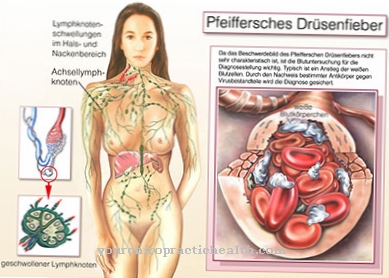Pfeiffer's glandular fever or infectious mononucleosis is an infectious disease that is very common. The main symptoms caused by the Epstein-Barr virus (EBV) are swelling of the lymph nodes and fever.
What is Pfeiffer's glandular fever?

© Henrie - stock.adobe.com
Usually it is Pfeiffer's glandular fever a very common, harmless viral disease. It is caused by the Epstein-Barr virus. The infection can easily be detected via the blood count. According to estimates, over 90% of the population are infected with Pfeiffer's glandular fever up to the age of 30.
At least in children up to the end of the 10th year of age, Pfeiffer's glandular fever runs without major symptoms. In the elderly, flu-like symptoms occur, which are rarely associated with complications. Typical symptoms of Pfeiffer's glandular fever can include be: swelling lymph nodes, sore throat or tonsillitis, dizziness and disorientation. The viruses therefore attack the organs of the lymphatic ring of the pharynx. The liver, heart and spleen can also be affected.
causes
The transmission of the pathogen from Glandular fever occurs mainly through the saliva. Further transmission paths can be the so-called contact, droplet or smear infection. Since the main transmission takes place from mouth to mouth, Pfeiffer's glandular fever is also known as "kissing disease", "student disease" (or "kissing disease").
Once you have become infected with the pathogen, it remains in the body for life, as with other herpes infections. Even after an outbreak of Pfeiffer's glandular fever or after the disease has ended, the virus can still be transmitted to non-immune people via saliva. Likewise, after the disease has completely healed, the infected person can experience repeated outbreaks of symptoms. This renewed outbreak of the disease can be proven at any time by a corresponding blood count.
Symptoms, ailments & signs
Since the period from infection to the onset of the disease in Pfeiffer's glandular fever is very long, the typical symptoms appear late. There is a difference between the symptoms in adults and those in children. Since the immune system of children is not yet fully developed and therefore does not react as strongly to the virus, they often remain completely symptom-free.
In contrast, adults are much more affected by the effects. They suffer from tiredness and a general feeling of illness, feel weak and exhausted. This languor can go on for a very long time before it is recognized as a sign of illness. Unpleasant sore throats, accompanied by reddening of the throat and difficulty swallowing are possible.
Sometimes the lymph nodes swell and the patient becomes febrile. In the further course, additional, but individually completely different, symptoms can occur. There are patients in whom the disease causes hepatitis; recognizable by the yellowing of the skin and the dermis of the eyes.
The spleen can also be affected and swell as a result. In individual cases, a nodular rash occurs that spreads raised and speckled on the skin. Rare complications in the form of paralysis and inflammation of the meninges only occur when the virus attacks the nervous system.
Course of disease
The incubation period of Glandular fever is seven to thirty days in children. In adults, this time can be between four to seven weeks.
Pfeiffer's glandular fever usually begins with fever, aching limbs and fatigue, so with relatively "normal" cold symptoms. The lymph nodes swell (possibly also under the armpits and groin) and the tonsils become inflamed.
Typical of Pfeiffer's glandular fever is the dirty-gray coating on the tonsils, which causes a putrid bad breath. In addition, some sufferers have hoarseness and speech disorders.
The disease usually lasts a few weeks, in the rarest of cases it can extend to 1-2 months.If the disease is asymptomanic, fatigue and persistent weakness can occur over a period of a few months to two years.
Complications
The complications that can occur with glandular fever are diverse but rare. Most of them also require therapy, but may require hospitalization. The situation is different for people with a weakened immune system (especially children). Here the disease can be severe or fatal.
This can lead to swelling of the liver or spleen. Both are painful to the touch and limit the function of the affected organs. Strong exertion and contortions should be avoided if the spleen is swollen, as they can lead to a rupture of the spleen. Jaundice can also occur.
Inflammation of the lungs, heart muscles, or kidneys can occur and usually require treatment. Kidney and heart infections in particular carry a risk of destruction of vital tissue and can cause consequential damage.
Anemia or a reduced number of blood platelets is possible. This worsens the debilitating phase of the illness and bleeding (nosebleeds, bleeding from injury, etc.) can be more difficult to control. It is important to avoid exertion and injuries.
Encephalitis can also occur. It requires special medical attention because it can affect the nerves - and thus the motor skills and cognitive abilities of the person affected.
When should you go to the doctor?
If the child has swollen lymph nodes, a sore throat, or a high fever, a doctor should be consulted. The doctor can make a diagnosis based on the number of white blood cells and, if necessary, initiate treatment immediately. Medical advice is particularly important in the case of increasing complaints that cannot be relieved by home remedies and bed rest. If Pfeiffer's glandular fever does not subside by itself, the pathogen must be fought with medication. The doctor can also prescribe fever suppositories and other aids.
Pfeiffer's glandular fever is treated by the family doctor, pediatrician or a specialist in internal medicine. If the Epstein-Barr virus has spread to the respiratory tract, the ear, nose and throat specialist must be involved in the treatment. Depending on whether complications arise, inpatient treatment may also be necessary. With appropriate drug treatment, the symptoms should subside within a few days to weeks. If this is not the case, the doctor must be informed. Parents should consult a doctor alone because of the risk of infection.
Treatment & Therapy
Unfortunately for the treatment of the Pfeiffer's glandular fever no special drug. In any case, it is necessary to drink a lot of fluids, as is generally advised in case of fever. Antipyretic medication and, in any case, plenty of time to rest are also helpful.
In some cases, a bacterial infection can also occur, which must be treated by taking antibiotics. In general, it is important to contact a doctor who will decide whether to take it. In general, care should be taken that the doctor does not use broad-spectrum antibiotics such as Amoxicillin, or ampicillin, prescribes. These can cause widespread, itchy rashes all over the body. This rash can continue to develop up to three days after taking the antibiotic. The rash can take up to two weeks to subside and can be very painful. This is not an allergy, "just" an overreaction.
Aftercare
Pfeiffer's glandular fever is a protracted disease. Follow-up care includes rest and regular check-ups by the doctor. Patients should rest for at least four to six weeks. If the outcome is positive, the doctor should be consulted weekly. The responsible internist or general practitioner will take care of the aftercare.
The doctor will draw blood from the patient and perform a physical exam. Follow-up care also includes taking a medical history to clarify open questions and assess the patient's current state of health. After Pfeiffer's glandular fever has been cured, no further follow-up examinations are usually necessary.
If complications arise, medical advice is required. The doctor will first check typical symptoms such as yellow skin and the increased body temperature in order to determine or rule out involvement of the internal organs. A hospital stay may then be required. If the course is complicated, further follow-up examinations by the responsible specialists are necessary.
The doctor must examine the internal organs in order to rule out organ damage and concomitant diseases. Depending on the cause of Pfeiffer's glandular fever, further medical appointments may have to be made after the follow-up care. The cause of the disease must be identified and corrected before treatment can be completed.
You can find your medication here
➔ Medicines for fever and chillsOutlook & forecast
The chances of a complete cure are very good in Pfeiffer's glandular fever. The disease usually heals within two to three weeks without complications or consequential damage. In people whose immune system is weakened, e.g. B. by HIV infection or after an organ transplant, however, there is an increased risk of a course with complications.
Possible consequential damage is inflammation of the heart, liver, kidneys or brain. There is a risk of additional bacterial or viral infections that worsen the prognosis. In very rare cases, the enlarged spleen may tear. This is an emergency that requires immediate surgery. In some cases, lymphomas develop in immunocompromised people. These are tumors that develop from altered white blood cells and which can later become malignant.
Antibodies against the Epstein-Barr virus are formed after an infection with Pfeiffer's glandular fever. There is usually lifelong immunity after the first infection. However, re-infection in immunocompromised people is quite possible. To avoid re-infection, contact with sick people should be avoided. Since the infection only occurs through direct contact, the risk of re-infection can be reduced.
You can do that yourself
For the supportive therapy of Pfeiffer's glandular fever, first and foremost, bed rest when the fever occurs. Physical rest provides the body with the strength it needs to defend itself against viruses. Good results in lowering fever can be achieved by using leg wraps.
In the case of sick people in general, especially children, it is important to ensure adequate fluid intake and the administration of easily digestible food during the infection. In addition to the fever attacks, the patients often experience severe sore throats. These can be relieved by gargling with sage tea or warm salt water.
Furthermore, inhaling chamomile flower tea can have a positive effect on the sore throat. If the sore throat develops into bacterial angina, a doctor must be consulted, as the administration of antibiotics is then indicated. Severe headaches and body aches can be counteracted with commercially available painkillers. However, patients must ensure that the pain reliever they use is not acetylsalicylic acid-based. Bleeding could occur here.
After the symptoms of the disease have subsided, patients should take it easy for four to eight weeks. Lifting heavy loads during this time is particularly dangerous as it can easily rupture the spleen. In general, if you exercise too early, there is a risk of injury to the spleen.














.jpg)













